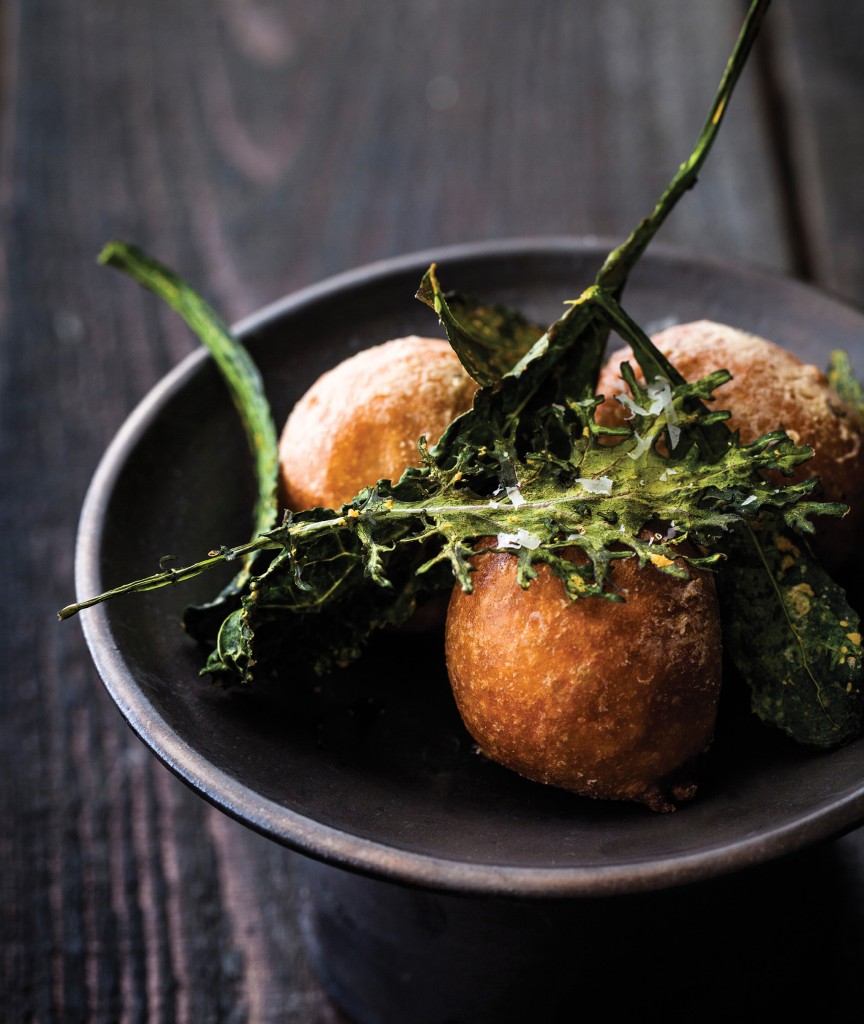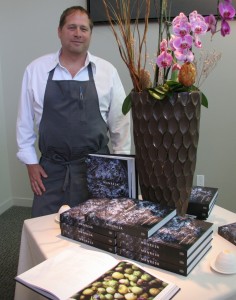 August 20, 2013 – A reporter’s income affords few opportunities to dine at expensive restaurants, so I jumped at the chance to join a handful of other food writers at a media lunch held last Friday to launch David Kinch’s new book Manresa: An Edible Reflection—a compilation of beautifully photographed recipes interwoven with the story of his Los Gatos restaurant and the evolution of his trailblazing cooking style.
August 20, 2013 – A reporter’s income affords few opportunities to dine at expensive restaurants, so I jumped at the chance to join a handful of other food writers at a media lunch held last Friday to launch David Kinch’s new book Manresa: An Edible Reflection—a compilation of beautifully photographed recipes interwoven with the story of his Los Gatos restaurant and the evolution of his trailblazing cooking style.
Kinch—who opened Manresa in 2002—said he’d been thinking about doing a book for six or seven years but didn’t feel he was ready until last year. Then the 327-page publication “came together rather quickly.” He worked on it over the course of 15 months, mainly on Mondays and Tuesdays when the restaurant is closed, creating dishes that cover all the seasons of a year. Watch for a full review by one of our writers, Lis Bensley, in the Fall 2013 issue of Edible Monterey Bay, coming out on September 1.
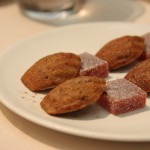 But back to lunch, our introduction to Manresa started with his signature savory Petit Fours, a perfect square of red pepper jelly accompanied by tiny black olive madeleines—an amuse bouche that looks like dessert but surprises with it’s appetizer flavors, making you wonder just what this chef is up to.
But back to lunch, our introduction to Manresa started with his signature savory Petit Fours, a perfect square of red pepper jelly accompanied by tiny black olive madeleines—an amuse bouche that looks like dessert but surprises with it’s appetizer flavors, making you wonder just what this chef is up to.
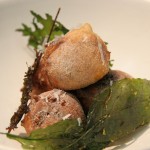 Our first appetizer was the delicious Garden Beignets and Crispy Leaves, which Kinch said was one of the easier recipes to try at home (see recipe below). In a nod to his New Orleans childhood, the chef makes balls of sautéed greens with grated Parmesan, coats them in batter and deep fries. The crispy leaves are simply oven-baked baby kale.
Our first appetizer was the delicious Garden Beignets and Crispy Leaves, which Kinch said was one of the easier recipes to try at home (see recipe below). In a nod to his New Orleans childhood, the chef makes balls of sautéed greens with grated Parmesan, coats them in batter and deep fries. The crispy leaves are simply oven-baked baby kale.
“I found out that writing recipes is no fun,” said Kinch, who loves to experiment in the kitchen with a handful of this or a sprinkling of that. “We also use the metric system and a scale for weighing out ingredients—we don’t do it because it’s fancy, we do it because it just works and home cooks have got to start doing it.”
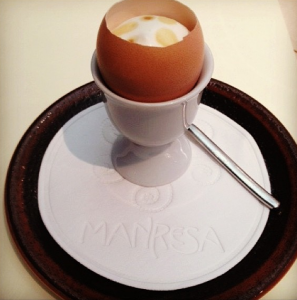 Our second appetizer was the Arpège Farm Egg—another Manresa signature dish served on every tasting menu as a tribute to chef Alain Passard and his Arpège restaurant in Paris. The egg takes up an entire chapter of the Manresa book and Kinch says Passard is the chef who has most inspired him. He said of the Arpège egg: “With the first taste, my culinary world made sense; this dish brought together everything that I believed cooking should be. Each of the two bites contained an explosion of sweet, salt, sour, slight bitterness, umami, and hot and cold temperatures presented in nature’s most beautifully shaped vessel, the eggshell.”
Our second appetizer was the Arpège Farm Egg—another Manresa signature dish served on every tasting menu as a tribute to chef Alain Passard and his Arpège restaurant in Paris. The egg takes up an entire chapter of the Manresa book and Kinch says Passard is the chef who has most inspired him. He said of the Arpège egg: “With the first taste, my culinary world made sense; this dish brought together everything that I believed cooking should be. Each of the two bites contained an explosion of sweet, salt, sour, slight bitterness, umami, and hot and cold temperatures presented in nature’s most beautifully shaped vessel, the eggshell.”
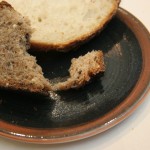 As an interlude, we were treated to Manresa bread and butter. Butter is churned at the restaurant and seasoned with sea salt also made on site with seawater from the Pacific Ocean—both recipes are in the book. Manresa’s dense, flavorful bread has built something of a cult following with shoppers lining up to buy it on Sundays at the farmers’ market in Campbell. The farmers’ market experiment started in March and has been such a success that Kinch is scouting South Bay locations for a permanent bakery he hopes to have up and running by next Spring.
As an interlude, we were treated to Manresa bread and butter. Butter is churned at the restaurant and seasoned with sea salt also made on site with seawater from the Pacific Ocean—both recipes are in the book. Manresa’s dense, flavorful bread has built something of a cult following with shoppers lining up to buy it on Sundays at the farmers’ market in Campbell. The farmers’ market experiment started in March and has been such a success that Kinch is scouting South Bay locations for a permanent bakery he hopes to have up and running by next Spring.
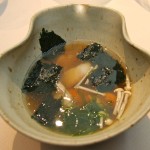 Our meal continued with Summer Tidal Pool, a stunning mélange of shellfish, sea bream, sea urchin, pine mushrooms and sea lettuces in a briny broth made for drinking straight from the bowl Japanese-style. Kinch lives in Santa Cruz and often goes surfing in the morning before heading to work, so this dish was an expression of his love for the sea and riding the waves. It was about at this point that I began to think of the meal as a work of experiential art, rather than a lunch. Very rare and very special.
Our meal continued with Summer Tidal Pool, a stunning mélange of shellfish, sea bream, sea urchin, pine mushrooms and sea lettuces in a briny broth made for drinking straight from the bowl Japanese-style. Kinch lives in Santa Cruz and often goes surfing in the morning before heading to work, so this dish was an expression of his love for the sea and riding the waves. It was about at this point that I began to think of the meal as a work of experiential art, rather than a lunch. Very rare and very special.
All vegetables and most fruits served at Manresa come from Love Apple Farms in the Santa Cruz Mountains (see EMB Spring 2012.) In his book, Kinch says he “struggled to find my voice on the plate” before meeting Love Apple Farms owner Cynthia Sandberg and creating a partnership that would allow him access to fresh, unrefrigerated ingredients grown just 15 minutes away from the restaurant. He often stops by the farm to see how things are growing on his way to work in the morning. Kinch says of his hyper-local cooking: “It’s not just California cuisine. It’s Los Gatos cuisine.”
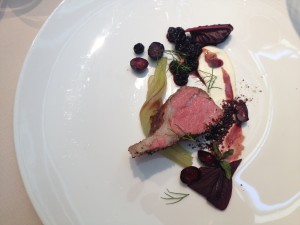 Next came a plate/canvass painted with a baby Roast Lamb Chop and Cucumber, with blueberries, juniper and olives. The cucumber, cut into “noodles” and compressed with lemon vinegar, olive oil and salt, provided a refreshing counterpoint to the rich meat, while warmed blueberries burst with sweet juice. Although delicious, it felt kind of wrong to disturb the careful composition.
Next came a plate/canvass painted with a baby Roast Lamb Chop and Cucumber, with blueberries, juniper and olives. The cucumber, cut into “noodles” and compressed with lemon vinegar, olive oil and salt, provided a refreshing counterpoint to the rich meat, while warmed blueberries burst with sweet juice. Although delicious, it felt kind of wrong to disturb the careful composition.
But when it comes to artists in the kitchen, pastry chefs are the stars. So the dessert course by Manresa pastry chef Stephanie Prida was a real stunner. She made Milk and Chocolate, a simple sounding but very complex deconstruction of a glass of chocolate milk. It combined a disk of milk chocolate mousse, dollops of dulce de leche, tangy buttermilk sorbet and chips of milk meringue, surrounded by cocoa nib streusel. The recipe is in the book and it doesn’t look too hard, just incredibly time consuming to create all ten components of the dish. Which is why I’m thinking about forgoing all eating out for the next few months to save up for a return trip to Manresa.
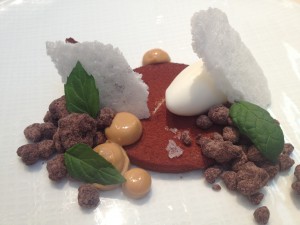 Lastly, another plate of Petit Fours was brought out—identical in appearance to the ones that began our meal, but this time flavored with strawberry and chocolate. It was a perfect way to close the circle on a fabulous meal.
Lastly, another plate of Petit Fours was brought out—identical in appearance to the ones that began our meal, but this time flavored with strawberry and chocolate. It was a perfect way to close the circle on a fabulous meal.
A representative for the publisher—Ten Speed Press of Berkeley—said that the publication of Manresa: An Edible Reflection brings a new voice to California cuisine. “Following in the tradition of Alice Waters and Jeremiah Towers, David Kinch is taking the idea of locally sourced ingredients, simply prepared to the second generation,” said publicist Keelin Czellecz.
Recipes for all the dishes we enjoyed at the media lunch and many, many more are contained in the book, which goes on sale to the public starting October 22.
garden beignets and crispy leaves
makes 18 to 20 beignets
| Beignet Centers |
200 grams (7 ounces) greens, including mustard, kale, and chard, stems removed (8 cups, tightly packed)
100 grams (1 cup) thinly sliced white onion
15 grams (1 tablespoon) butter
15 grams (1 tablespoon) extra-virgin olive oil
3 grams (1/2 teaspoon) kosher salt, plus more as needed
55 grams (2 ounces) aged goat’s milk Cheddar or Parmigiano-Reggiano, finely grated
Sweat the greens and onion in the butter and oil in a heavy covered pan over low heat for 40 to 45 minutes, stirring occasionally, until they are very tender. Season with salt and cool to room temperature. Finely chop the vegetables and, using your hands, mix in the cheese. Add more salt if needed. Roll into 1-inch-diameter balls, approximately 10 to 12 grams each, cover with plastic wrap, and reserve in the refrigerator for up to 1 week.
| Beignet Batter |
5 grams (2 teaspoons) active dry yeast
200 grams (3/4 cup plus 2 tablespoons) whole milk, warmed to less than 90°F (30°C)
1 egg white, whisked to a light froth
185 grams (1 cup plus 2 tablespoons) all-purpose flour
40 grams (3 tablespoons) sugar
6 grams (1 teaspoon) kosher salt
Sprinkle the yeast over the warm milk and set aside in a warm place for about 10 minutes to activate. Combine the dry ingredients. Add the yeast mixture to the egg white. Whisk in the dry ingredients and mix until the batter is smooth. Proof at room temperature for about 1 hour. Extra batter—enough to coat a second batch of Beignet Centers—will hold for a few days in the refrigerator. Bring to room temperature before using.
| Kale Chips |
25 to 30 small (3- to 4-inch) kale leaves (black Toscano or red Russian)
Approximately 6 grams (11/2 teaspoons) extra-virgin olive oil
Approximately 3 grams (1/2 teaspoon) kosher salt
Approximately 2 grams (1 teaspoon) nutritional yeast
Preheat the oven to 325°F (165°C). If you have a convection oven, set the fan on low.
Gently toss the kale leaves with just enough olive oil to coat them with a light film. Season to taste with salt and yeast. Place the leaves between two silicone baking mats on a baking sheet and bake for 5 minutes. Remove the top mat and bake for another 5 minutes. Turn the leaves over, rotate the pan, and bake again for 5 minutes. Continue to turn and bake until crispy, 2 to 3 rotations. Store in a dry box (see page 310).
> To Serve
Grapeseed oil, for-deep frying
10 grams (2 tablespoons) malt vinegar powder
25 grams (1 ounce) aged goat’s milk Cheddar or Parmigiano-Reggiano
Heat the grapeseed oil for deep-frying to 350°F (175°C).
Using 2 spoons, thickly coat the chilled Beignet Centers in the Beignet Batter and fry in the grapeseed in small batches for a few minutes, turning and basting with oil, until golden brown. Drain on paper towels, snip off any tails of batter with scissors, then roll the hot beignets in a little of the malt vinegar powder. Arrange the beignets on serving plates, grate cheese over the beignets, garnish with Kale Chips, and serve immediately.
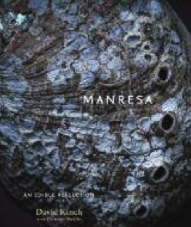 Reprinted with permission from Manresa by David Kinch with Christine Muhlke, (c) 2013. Published by Ten Speed Press, a division of Random House, Inc.
Reprinted with permission from Manresa by David Kinch with Christine Muhlke, (c) 2013. Published by Ten Speed Press, a division of Random House, Inc.
Garden Beignets Photo by: Eric Wolfinger. Pre-order copies of Manresa: An Edible Reflection at your local bookshop or online at indiebound.org or amazon.com
About the author
Deborah Luhrman is publisher and editor of Edible Monterey Bay. A lifelong journalist, she has reported from around the globe, but now prefers covering our flourishing local food scene and growing her own vegetables in the Santa Cruz Mountains.
- Deborah Luhrmanhttps://www.ediblemontereybay.com/author/dluhrman/
- Deborah Luhrmanhttps://www.ediblemontereybay.com/author/dluhrman/
- Deborah Luhrmanhttps://www.ediblemontereybay.com/author/dluhrman/
- Deborah Luhrmanhttps://www.ediblemontereybay.com/author/dluhrman/


